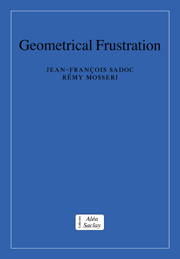Book contents
- Frontmatter
- Contents
- Preface
- 1 Introduction to geometrical frustration
- 2 Ideal models
- 3 Finite structures
- 4 Decurving and disclinations
- 5 Hierarchical polytopes
- 6 Some physical properties
- 7 Periodic structures with large cells
- 8 Quasiperiodic order and frustration
- A1 Spaces with constant curvature
- A2 Quaternions and related groups
- A3 Hopf fibration
- A4 Polytopes and honeycombs
- A5 Polytope {3, 3, 5}
- A6 Frank and Kasper coordination polyhedra
- A7 Quasiperiodic tilings: cut and projection
- A8 Differential geometry and parallel transport
- A9 Icosahedral quasicrystals and the E8 lattice
- Bibliography
- Index
A4 - Polytopes and honeycombs
Published online by Cambridge University Press: 06 January 2010
- Frontmatter
- Contents
- Preface
- 1 Introduction to geometrical frustration
- 2 Ideal models
- 3 Finite structures
- 4 Decurving and disclinations
- 5 Hierarchical polytopes
- 6 Some physical properties
- 7 Periodic structures with large cells
- 8 Quasiperiodic order and frustration
- A1 Spaces with constant curvature
- A2 Quaternions and related groups
- A3 Hopf fibration
- A4 Polytopes and honeycombs
- A5 Polytope {3, 3, 5}
- A6 Frank and Kasper coordination polyhedra
- A7 Quasiperiodic tilings: cut and projection
- A8 Differential geometry and parallel transport
- A9 Icosahedral quasicrystals and the E8 lattice
- Bibliography
- Index
Summary
Symmetries and orthoscheme tetrahedra
Group generated by reflections. The characteristic triangle
Let us consider a triangle ABC, with angles α, β, γ, located on any surface, either Euclidean, spherical or hyperbolic, and let a, b, c denote the simple reflections in the sides BC, AC and AB (du Val 1964). In the following we shall embed the spherical geometry in R3 as the standard sphere S2. ABC becomes in this case a spherical triangle, whose sides are great circle arcs; a, b and c are then the simple reflections in the planes defined by these great circles. In the hyperbolic space case, we shall use the unit disc conformal model (appendix A1). The triangle sides are now arcs of circles orthogonal to the absolute (these lines can degenerate into straight parts of a diameter when the geodesies run through the origin), and reflections in the sides are replaced by inversion with respect to these circles (figure A4.1).
Let us first briefly recall what a circle inversion is. Consider a circle of centre O and radius r in the Euclidean plane and a point M anywhere in that plane. The inverse M′ of M with respect to the circle is located on the line OM at a position such that OM.OM′ = r2.
The three types of triangle are represented in figure A4.2.
It is possible to generate rotations by combining the reflections. For example the symmetry operations obtained as the products b.c, c.a and a.b are rotations of angles 2α, 2β and 2γ about A, B and C respectively.
- Type
- Chapter
- Information
- Geometrical Frustration , pp. 237 - 247Publisher: Cambridge University PressPrint publication year: 1999



